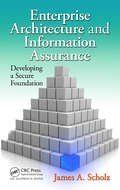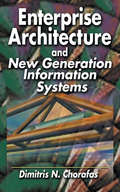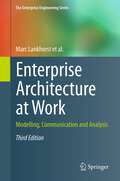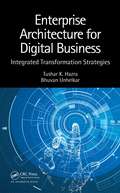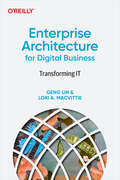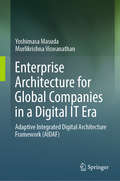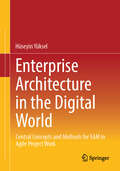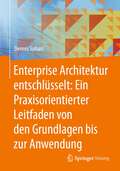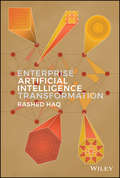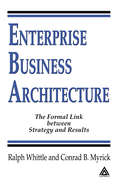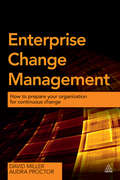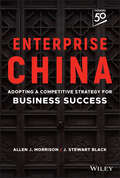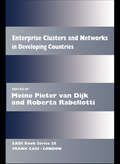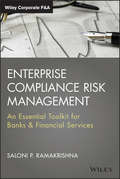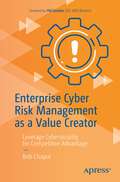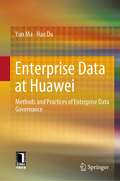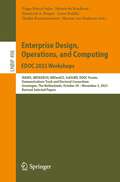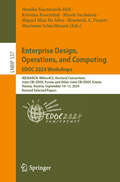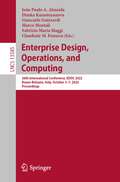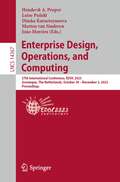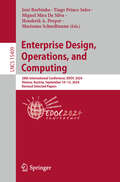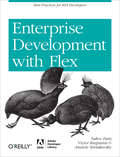- Table View
- List View
Enterprise Architecture and Information Assurance: Developing a Secure Foundation
by James A. ScholzThis book provides guidance on designing complex, highly available enterprise architectures that integrate the most critical aspects of an organization's business processes. Considering the lack of tolerance of enterprise for operational interruptions or the risks that accompany theft and loss of data, this reference describes how to ensure your organization is prepared for the unexpected. The text also aids in containing liability with guidance on network and application vulnerability assessments, intrusion detection and penetration testing, incident response planning, risk mitigation audits/reviews, and business continuity and disaster recovery planning.
Enterprise Architecture and New Generation Information Systems
by Dimitris N. ChorafasBased on an extensive research project done by the author in the United States, Britain, Germany, France, Switzerland, Sweden, and Austria from December 1999 to June 2001, Enterprise Architecture and New Generation Information Systems focuses on four main themes: Next Generation Information Technology The Likely Technologies
Enterprise Architecture at Work: Modelling, Communication and Analysis
by Marc LankhorstAn enterprise architecture tries to describe and control an organisation's structure, processes, applications, systems and techniques in an integrated way. The unambiguous specification and description of components and their relationships in such an architecture requires a coherent architecture modelling language. Lankhorst and his co-authors present such an enterprise modelling language that captures the complexity of architectural domains and their relations and allows the construction of integrated enterprise architecture models. They provide architects with concrete instruments that improve their architectural practice. As this is not enough, they additionally present techniques and heuristics for communicating with all relevant stakeholders about these architectures. Since an architecture model is useful not only for providing insight into the current or future situation but can also be used to evaluate the transition from 'as-is' to 'to-be', the authors also describe analysis methods for assessing both the qualitative impact of changes to an architecture and the quantitative aspects of architectures, such as performance and cost issues. The modelling language presented has been proven in practice in many real-life case studies and has been adopted by The Open Group as an international standard. So this book is an ideal companion for enterprise IT or business architects in industry as well as for computer or management science students studying the field of enterprise architecture.
Enterprise Architecture for Digital Business: Integrated Transformation Strategies
by Bhuvan Unhelkar Tushar K. HazraEnterprise Architecture (EA) is an essential part of the fabric of a business; however, EA also transcends and transforms technology and moves it into the business space. Therefore, EA needs to be discussed in an integrated, holistic, and comprehensive manner. Only such an integrated approach to EA can provide the foundation for a transformation that readies the business for the myriad enterprise-wide challenges it will face. Highly disruptive technologies such as Big Data, Machine Learning, and Mobile and Cloud Computing require a fine balance between their business and technical aspects as an organization moves forward with its digital transformation. This book focuses on preparing all organizations – large and small – and those wishing to move into them for the impact of leveraging these emerging, disruptive, and innovative technologies within the EA framework.
Enterprise Architecture for Digital Business: Transforming IT
by Geng Lin Lori A. MacVittieDigital transformation has accelerated nearly tenfold in recent years as both a business and technology journey. Yet, most white papers and how-to guides still focus solely on the business side, rather than include methods for optimizing the technology behind it. This handbook shows CIOs, IT directors, and architects how to balance these two concerns successfully.You'll explore current technology trends and shifts required to build a digital business, including how enterprise architecture should evolve if it's to sustain and grow your business. A CIO who can handle digital transformation along with business interests is a rare find. This is the ideal guide to modernizing IT.You'll examine:The latest trends and technologies driving the need for a digital enterprise architectureNew components, layers, and concepts that comprise a framework for digital enterprise architectureSkills and technologies you need to modernize an enterprise architecture for a digital businessDomains and characteristics of a digital enterprise architectureHow to map digital enterprise technologies to the appropriate teams
Enterprise Architecture for Global Companies in a Digital IT Era: Adaptive Integrated Digital Architecture Framework (AIDAF)
by Yoshimasa Masuda Murlikrishna ViswanathanThis book investigates solutions incorporated by architecture boards in global enterprises to resolve issues and mitigate related architecture risks, while also proposing and implementing an adaptive integrated digital architecture framework (AIDAF) and related models and approaches/platforms, which can be applied in companies to promote IT strategies using cloud/mobile IT/digital IT. The book is divided into three main parts, the first of which (Chapters 1–2) addresses the background and motivation for AIDAF aligned with digital IT strategies. The second part (Chapter 3) provides an overview of strategic enterprise architecture (EA) frameworks for digital IT, elaborates on the essential elements of EA frameworks in the digital IT era, and advocates using AIDAF, models for architecture assessment/risk management, knowledge management on digital platforms. In turn, the third part (Chapters 4–7) demonstrates the application and benefits of AIDAF and related models, as shown in three case studies. “I found this book to be a very nice contribution to the EA community of practice. I can recommend this book as a textbook for digital IT strategists/practitioners, EA practitioners, students in universities and graduate schools.” (From the Foreword by Scott A. Bernard) “In this new age of the digital information society, it is necessary to advocate a new EA framework. This book provides state-of-the art knowledge and practices about EA frameworks beneficial for IT practitioners, IT strategists, CIO, IT architects, and even students. It serves as an introductory textbook for all who drive the information society in this era.”(From the Foreword by Jun Murai)
Enterprise Architecture in the Digital World: Central Concepts and Methods for EAM in Agile Project Work
by Hüseyin YükselHow do companies achieve the transformation into an agile, innovative, digital business and work environment? This question concerns not only IT managers but also strategic players, the enterprise architects. They must bridge the gap between strategic planning and dealing with increasing speed and growing uncertainty. Holistic enterprise development in the digital future means developing digital ecosystems and complex IT landscapes. This book presents methods and concepts from the agile world, semiotics, and neuropsychology that can help enterprise architects in their practical everyday work. Starting from a positive view of humanity, it is possible to harness the potential of individuals and teams for digital transformation with fundamental knowledge. The book is primarily aimed at IT managers, enterprise architects, and managers involved in large-scale software development processes. Many practical examples illustrate the theoretically presented connections and provide broader access to enterprise architecture management.
Enterprise Architektur entschlüsselt: Ein Praxisorientierter Leitfaden von den Grundlagen bis zur Anwendung
by Dennis SuhariEntdecken Sie "Enterprise Architektur entschlüsselt: Ein praxisorientierter Leitfaden von den Grundlagen bis zur Anwendung“ von Dennis Suhari, ein praxisorientiertes Werk, das die Förderung des Bewusstseins für Enterprise Architektur, die Vermittlung praktischer Erfahrungen und die Unterstützung der Leser bei der erfolgreichen Anwendung ihres Wissens in den Mittelpunkt stellt. Ein Schlüsselelement dieses Buches ist das praxisnahe Fallbeispiel, das einen einzigartigen Einblick in den Aufbau einer Enterprise Architektur von der Geschäfts- über die IT Architektur von Grund auf bietet.Was Sie erwartet:Fundamentale Grundlagen: Ein tiefgreifender Einblick in die essenziellen Grundlagen der Unternehmensarchitektur, um Schlüsselkonzepte und Prinzipien zu vermitteln, die als robuste Basis für die weitere Entwicklung dienen.Modellierung und praktische Tools: Entdecken Sie vielfältige Modellierungsmöglichkeiten und EAM-Tools, die inder Praxis zur Unterstützung der Architekturentwicklung eingesetzt werden.Architekturentwicklung in der Praxis: Anhand des Fallbeispiels der fiktiven Micayu GmbH, basierend auf den umfangreichen Erfahrungen des Autors, erleben Sie die Schritte der Entwicklung einer Unternehmensarchitektur von Grund auf.Zukunftsperspektiven: Ein Ausblick auf die Rolle der Künstlichen Intelligenz und dessen Einfluss auf das Enterprise Architektur Management
Enterprise Artificial Intelligence Transformation
by Rashed HaqEnterprise Artificial Intelligence Transformation AI is everywhere. From doctor's offices to cars and even refrigerators, AI technology is quickly infiltrating our daily lives. AI has the ability to transform simple tasks into technological feats at a human level. This will change the world, plain and simple. That's why AI mastery is such a sought-after skill for tech professionals. Author Rashed Haq is a subject matter expert on AI, having developed AI and data science strategies, platforms, and applications for Publicis Sapient's clients for over 10 years. He shares that expertise in the new book, Enterprise Artificial Intelligence Transformation. The first of its kind, this book grants technology leaders the insight to create and scale their AI capabilities and bring their companies into the new generation of technology. As AI continues to grow into a necessary feature for many businesses, more and more leaders are interested in harnessing the technology within their own organizations. In this new book, leaders will learn to master AI fundamentals, grow their career opportunities, and gain confidence in machine learning. Enterprise Artificial Intelligence Transformation covers a wide range of topics, including: Real-world AI use cases and examples Machine learning, deep learning, and slimantic modeling Risk management of AI models AI strategies for development and expansion AI Center of Excellence creating and management If you're an industry, business, or technology professional that wants to attain the skills needed to grow your machine learning capabilities and effectively scale the work you're already doing, you'll find what you need in Enterprise Artificial Intelligence Transformation.
Enterprise Business Architecture: The Formal Link between Strategy and Results
by Ralph Whittle Conrad B. MyrickA critical part of any company's successful strategic planning is the creation of an Enterprise Business Architecture (EBA) with its formal linkages. Strategic research and analysis firms have recognized the importance of an integrated enterprise architecture and they have frequently reported on its increasing value to successful companies. Enterpr
Enterprise Change Management: How to Prepare Your Organization for Continuous Change
by David Miller Audra ProctorOne of the biggest challenges facing organizations today is the ability to deliver the necessary change to sustain competitive advantage and adapt to economic and market environments. However, the gap between what organizations would like to deliver and their capabilities to do so is getting increasingly wide. Enterprise Change Management provides a practical roadmap for bridging this gap to help organizations build the sustainable capabilities to implement a portfolio of changes. Based on research on change performance from over 300 organizations and 400,000 data points over a 21-year period, Enterprise Change Management will help diagnose the root causes of the organizational change gap, manage demand for change and create the context for successful continuous change in the organization. This book introduces five core capabilities - adaptive leadership; executing single changes effectively; managing the demand for change; hiring resilient people and creating the context for successful change. Frameworks, processes and tools help readers assess change capabilities and then create a strategy to close the change gap and improve performance in their organization.
Enterprise China: Adopting a Competitive Strategy for Business Success
by J. Stewart Black Allen J. MorrisonHow to adapt your firm&’s competitive strategy to the modern reality of Chinese enterprise Enterprise China: Adopting a Competitive Strategy for Business Success delivers a roadmap for business executives competing in and with China. Prepared by a team of renowned management researchers and strategists, the book examines the often-misunderstood interconnectedness of the Chinese state and Chinese businesses, demonstrating that individual firms and companies are often just the tip of the iceberg. The authors explain how the overarching vision, ambition, and strategy of the State impact and guide key commercial enterprises and how this affects Western business interests. In the book, you&’ll also find: Explorations of the competitive strategy and associated tactics of Chinese enterprise Strategies and tactical options for Western business executives as they compete in and with the Chinese state Descriptions of the key factors business executives must assess as they do business in and with ChinaAn essential discussion of one of the great economic powerhouses of contemporary history, Enterprise China belongs in the libraries of business executives, policy makers, and thought leaders seeking perspective on an unavoidable and determined competitor.
Enterprise Clusters and Networks in Developing Countries (Routledge Research EADI Studies in Development #Vol. 20)
by Meine Pieter van Dijk Roberta RabellottiEnterprise Clusters and Networks in Developing Countries analyses the functions and advantages of clusters and networks for small enterprises in developing countries.In the opening chapter the editors describe different types of clusters and networks and compare the diverse forms of external economies and co-operation effects derived from them. Taking a multidiscplinary approach, they point out it is trust that is the social basis for positive effects of clustering and networking, which are often sources of co-operation and technology diffusion for small enterprises in developing countries.
Enterprise Compliance Risk Management
by Saloni Ramakrishnacomprehensive reference, providing a framework for keeping up-to-date with the multitude of diverse legal requirements and guidelines bankers face. Topics include:Active compliance management as a strategic interventionConnections to reputation, legal risk, governance, and customer satisfactionThe entire ecosystem of stakeholders outside of designated compliance officersOperation, training, and reporting of various compliance modelsThe book also includes a direct examination of "risk", including identification, measurement, mitigation, monitoring, remediation, and regulatory dialogue, and an exploration of multidimensional financial services that points out focal points for active compliance management. Compliance professionals seeking a handle on this vital but fledgling discipline can find the information they need in Enterprise Compliance Risk Management.
Enterprise Cyber Risk Management as a Value Creator: Leverage Cybersecurity for Competitive Advantage
by Bob ChaputThis book will help you learn the importance of organizations treating enterprise cyber risk management (ECRM) as a value creator, a business enabler, and a mechanism to create a competitive advantage. Organizations began to see the real value of information and information technology in the mid-1980s. Forty years later, it’s time to leverage your ECRM program and cybersecurity strategy in the same way. The main topics covered include the case for action with specific coverage on the topic of cybersecurity as a value creator, including how the courts, legislators, and regulators are raising the bar for C-suite executives and board members. The book covers how the board’s three primary responsibilities (talent management, strategy, and risk management) intersect with their ECRM responsibilities.ECRM was once solely focused on managing the downside of risk by defending the organization from adversarial, accidental, structural, and environmental threat sources. Author Bob Chaput presents the view that we must focus equally on managing the upside of cyber strengths to increase customer trust and brand loyalty, improving social responsibility, driving revenue growth, lowering the cost of capital, attracting higher quality investments, creating competitive advantage, attracting and retaining talent, and facilitating M&A work. He focuses on the C-suite and board role in the first part and provides guidance on their roles and responsibilities, the most important decision about ECRM they must facilitate, and how to think differently about ECRM funding. You will learn how to the pivot from cost-center thinking to value-center thinking.Having built the case for action, in the second part, the book details the steps that organizations must take to develop and document their ECRM program and cybersecurity strategy. The book first covers how ECRM must be integrated into business strategy. The remainder of that part presents a sample table of contents for an ECRM Program and Cybersecurity Strategy document and works through each section to facilitate development of your own program and strategy. With all the content and ideas presented, you will be able to establish, implement, and mature your program and strategy.What You Will LearnRead new information and treat ECRM and cybersecurity as a value creatorReceive updates on legal cases, legislative actions, and regulations that are raising the stakes for organizations, their C-suites, and boardsThink differently about funding ECRM and cybersecurity initiativesUnderstand the most critical ECRM decision that boards must facilitate in their organizationsUse practical, tangible, actionable content to develop and document your ECRM program and cybersecurity strategy“This book should be mandatory reading for C-suite executives and board members. It shows you how to move from viewing cybersecurity as a risk to avoid, and a cost center that does not add value and is overhead, to seeing cybersecurity as an enabler and part of your core strategy to transform your business and earn customer and stakeholder trust.” —Paul Connelly, First CISO at the White House and HCA Healthcare Who This Book Is ForThe primary audience includes Chief Information Security Officers, Chief Risk Officers, and Chief Compliance Officers. The secondary audience includes C-suite executives and board members. The tertiary audience includes any stakeholder responsible for privacy, security, compliance, and cyber risk management or students of these topics.
Enterprise Cybersecurity in Digital Business: Building a Cyber Resilient Organization
by Ariel EvansCyber risk is the highest perceived business risk according to risk managers and corporate insurance experts. Cybersecurity typically is viewed as the boogeyman: it strikes fear into the hearts of non-technical employees. Enterprise Cybersecurity in Digital Business: Building a Cyber Resilient Organization provides a clear guide for companies to understand cyber from a business perspective rather than a technical perspective, and to build resilience for their business. Written by a world-renowned expert in the field, the book is based on three years of research with the Fortune 1000 and cyber insurance industry carriers, reinsurers, and brokers. It acts as a roadmap to understand cybersecurity maturity, set goals to increase resiliency, create new roles to fill business gaps related to cybersecurity, and make cyber inclusive for everyone in the business. It is unique since it provides strategies and learnings that have shown to lower risk and demystify cyber for each person. With a clear structure covering the key areas of the Evolution of Cybersecurity, Cybersecurity Basics, Cybersecurity Tools, Cybersecurity Regulation, Cybersecurity Incident Response, Forensics and Audit, GDPR, Cybersecurity Insurance, Cybersecurity Risk Management, Cybersecurity Risk Management Strategy, and Vendor Risk Management Strategy, the book provides a guide for professionals as well as a key text for students studying this field. The book is essential reading for CEOs, Chief Information Security Officers, Data Protection Officers, Compliance Managers, and other cyber stakeholders, who are looking to get up to speed with the issues surrounding cybersecurity and how they can respond. It is also a strong textbook for postgraduate and executive education students in cybersecurity as it relates to business.
Enterprise Data at Huawei: Methods and Practices of Enterprise Data Governance
by Yun Ma Hao DuThis book systematically introduces the data governance and digital transformation at Huawei, from the perspectives of technology, process, management, and so on. Huawei is a large global enterprise engaging in multiple types of business in over 170 countries and regions. Its differentiated operation is supported by an enterprise data foundation and corresponding data governance methods. With valuable experience, methodology, standards, solutions, and case studies on data governance and digital transformation, enterprise data at Huawei is ideal for readers to learn and apply, as well as to get an idea of the digital transformation journey at Huawei. This book is organized into four parts and ten chapters. Based on the understanding of “the cognitive world of machines,” the book proposes the prospects for the future of data governance, as well as the imaginations about AI-based governance, data sovereignty, and building a data ecosystem.
Enterprise Denied: Origins of the Decline of American Railroads, 1897-1917
by Albro MartinA 1971 piece that explores the struggle of the American Railroads in the early twentieth century.
Enterprise Design, Operations, and Computing. EDOC 2022 Workshops: IDAMS, SoEA4EE, TEAR, EDOC Forum, Demonstrations Track and Doctoral Consortium, Bozen-Bolzano, Italy, October 4–7, 2022, Revised Selected Papers (Lecture Notes in Business Information Processing #466)
by Giancarlo Guizzardi Marco Montali Henderik A. Proper Fabrizio Maria Maggi Claudenir M. Fonseca Tiago Prince SalesThis book constitutes revised selected papers from the international workshops, the EDOC Forum and the Demonstration and Doctoral Consortium track, that were held at the 26th International Conference on Enterprise Design, Operations, and Computing, EDOC 2022. The conference took place in Bozen-Bolzano, Italy, during October 3–7, 2022.The conference focuses on the area of enterprise computing, this year with the special emphasis on the theme of designing and operating “Flexible Enterprises”. Workshops within EDOC cover more focused topics and allow for the presentation and discussion of work that is in the earlier development stages. The 18 full and 8 short papers included in this volume were carefully reviewed and selected from 82 submissions. They stem from the following satellite events: – Workshop on Intelligent Digital Architecture, Methods, and Services for Industry 4.0 and Society 5.0 (IDAMS) – 14th Workshop on Service-oriented Enterprise Architecture for Enterprise Engineering (SoEA4EE) – 17th Workshop on Trends in Enterprise Architecture Research (TEAR) – EDOC Forum – Demonstrations Track – Doctoral Consortium
Enterprise Design, Operations, and Computing. EDOC 2023 Workshops: IDAMS, iRESEARCH, MIDas4CS, SoEA4EE, EDOC Forum, Demonstrations Track and Doctoral Consortium, Groningen, The Netherlands, October 30–November 3, 2023, Revised Selected Papers (Lecture Notes in Business Information Processing #498)
by Marten Van Sinderen Henderik A. Proper Sybren De Kinderen Dimka Karastoyanova Tiago Prince Sales Luise PufahlThis volume constitutes revised selected papers of several workshops, the EDOC Forum and the Demonstrations and Doctoral Consortium track, which were held in conjunction with the 27th International Conference on Enterprise Design, Operations, and Computing, EDOC 2023, in Groningen, The Netherlands, during October 30–November 3, 2023. The 18 revised full papers and 7 short papers presented in this book were carefully reviewed and selected from 37 submissions. They stem from the following satellite events: - Workshop on Intelligent Digital Architecture, Methods, and Services for Industry 4.0 and Society 5.0 (IDAMS)- Workshop on Empirical Methodologies for Research in Enterprise Architecture and Service-Oriented Computing (iRESEARCH)- Workshop on the Modelling and Implementation of Digital Twins for Complex Systems (MIDas4CS)- Workshop on Service-oriented Enterprise Architecture for Enterprise Engineering (SoEA4EE)- EDOC Forum- Demonstrations Track- Doctoral Consortium
Enterprise Design, Operations, and Computing. EDOC 2024 Workshops: iRESEARCH, MIDas4CS, Doctoral Consortium, Joint CBI–EDOC Forum and Other Joint CBI-EDOC Events, Vienna, Austria, September 10–13, 2024, Revised Selected Papers (Lecture Notes in Business Information Processing #537)
by Henderik A. Proper Monika Kaczmarek-Heß Marianne Schnellmann Kristina Rosenthal Marek Suchánek Miguel Mira Da SilvaThis volume constitutes revised selected papers of two workshops, the Doctoral Consortium, the Joint CBI-EDOC Forum and and other Joint CBI-EDOC event, which were held in conjunction with the 28th International Conference on Enterprise Design, Operations, and Computing, EDOC 2024, in Vienna, Austria, in September 10–13, 2024. The presented revised full papers in this book were carefully reviewed and selected. They stem from the following satellite events: iRESEARCH – 2nd International Workshop on Empirical Methodologies for Research in Enterprise Architecture and Service-oriented Computing MIDas4CS – 2nd Workshop on the Modelling and Implementation of Digital Twins for Complex Systems Joint CBI–EDOC Forum Joint CBI–EDOC Case Reports Track Joint CBI–EDOC Tools & Demos Track EDOC Doctoral Consortium CBI Mini Dagstuhl Seminars
Enterprise Design, Operations, and Computing: 26th International Conference, EDOC 2022, Bozen-Bolzano, Italy, October 3–7, 2022, Proceedings (Lecture Notes in Computer Science #13585)
by Giancarlo Guizzardi Marco Montali João Paulo A. Almeida Dimka Karastoyanova Fabrizio Maria Maggi Claudenir M. FonsecaThis book constitutes the proceedings of the 26th International Conference on Enterprise Design, Operations, and Computing, EDOC 2022, which took place in Bozen-Bolzano, Italy, in October 2022. The 15 full papers included in this book were carefully reviewed and selected from 48 submissions. They were organized in topical sections as follows: enterprise security; enterprise architecture; business process modeling and monitoring; business process mining and discovery; and process-driven applications.
Enterprise Design, Operations, and Computing: 27th International Conference, EDOC 2023, Groningen, The Netherlands, October 30 – November 3, 2023, Proceedings (Lecture Notes in Computer Science #14367)
by Marten Van Sinderen João Moreira Henderik A. Proper Dimka Karastoyanova Luise PufahlThis book constitutes the refereed proceedings of the 27th International Conference on Enterprise Design, Operations, and Computing, EDOC 2023, held in Groningen, The Netherlands, during October 30–November 3, 2023.The 12 full papers included in this book were carefully reviewed and selected from 36submissions. They were organized in topical sections as follows: Enterprise Modeling, Enterprise Architecture & Engineering, Model-Based Software Engineering, Enterprise Analysis with Process Mining, Process Improvement & Engineering, and Modeling in an Enterprise Context.
Enterprise Design, Operations, and Computing: 28th International Conference, EDOC 2024, Vienna, Austria, September 10–13, 2024, Revised Selected Papers (Lecture Notes in Computer Science #15409)
by Henderik A. Proper José Borbinha Tiago Prince Sales Marianne Schnellmann Miguel Mira Da SilvaThis book constitutes the refereed proceedings of the 28th International Conference on Enterprise Design, Operations, and Computing, EDOC 2024, held in Vienna, Austria, during September 10–13, 2024. The 18 full papers included in this book were carefully reviewed and selected from 70 submissions. They were organized in topical sections as follows: AI, ML and Agents; BPM and WFM; Business Models, Platforms and Strategic Management; Enterprise and IT Architecture; IT and Software Architecture; Modeling Methods, Data and Component; Process Mining and Monitoring; and Sustainability and Resilience.
Enterprise Development with Flex: Best Practices for RIA Developers (Adobe Developer Library)
by Yakov Fain Victor Rasputnis Anatole TartakovskyIf you want to use Adobe Flex to build production-quality Rich Internet Applications for the enterprise, this groundbreaking book shows you exactly what's required. You'll learn efficient techniques and best practices, and compare several frameworks and tools available for RIA development -- well beyond anything you'll find in Flex tutorials and product documentation. Through many practical examples, the authors impart their considerable experience to help you overcome challenges during your project's life cycle. Enterprise Development with Flex also suggests proper tools and methodologies, guidelines for determining the skill sets required for the project, and much more. Choose among several frameworks to build Flex applications, including Cairngorm, PureMVC, Mate, and Clear Toolkit Apply selected design patterns with Flex Learn how to extend the Flex framework and build your own component library Develop a sample AIR application that automatically synchronizes local and remote databases to support your sales force Get solutions for leveraging AMF protocol and synchronizing Flex client data modifications with BlazeDS-based servers Determine the actual performance of your application and improve its efficiency
